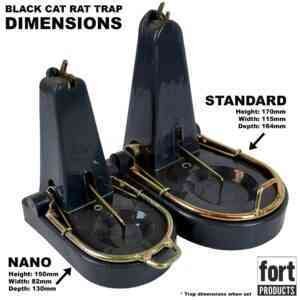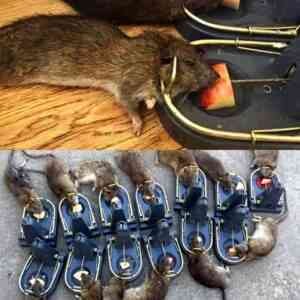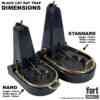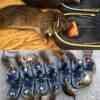
Heavy Duty ‘L’ Shaped Trap
Large heavy-duty trap
Powerful trap for the control of rats within small, medium and large infestations.
Traps should be placed within main areas of activity preferable close to either established feeding or nesting sites. A recommended location would be within an attic space or a confined area away from non-target access.
- Designed to kill rats
- Multi-kills are common due to large feeding well
- Unique activation trigger prevents misfires.
- A powerful spring bar results in a clean, humane kill.
Unlike standard rat traps, the trigger can not be activated until the spike in the centre of the food well has been activated. This results in faster acceptance of rats in large populations and allows rats to feed and trust the device. The high strength of the spring allows for a fast kill.
Due to the unique design, it is less likely to be triggered by slugs and snails, which can be a problem with standard traps.
The trap size is approximately 160mm x 160mm x 110mm. Due to this trap will not fit inside bait boxes or magnetic bases.
Setting of trap
- Find a suitable location for the placement of the trap.
- Place a solid piece of bait under the central trigger arm, such as an apple, carrot or meat.
- Place loose bait, such as oats, within the feeding well around the trigger arm.
- From behind use one hand to hold the tower of the trap firmly whilst using the other hand to pull up the U-shaped kill bar.
- Lock the U-shaped kill bar into the top catch.
- Do not touch the trap mechanism once set or place hands within the kill area.
- Place additional bait around the trap as an initial enticement.
- Check traps daily and remove bodies once caught.
Please note:
This trap can cause significant damage to users if not handled correctly. The trap should be treated with care, and instructions should be thoroughly read and understood before handling the trap.
Non-target animals must be kept away from the trap at all times.
Due to the size, we recommend only using the trap within enclosed areas such as an attic space, eave cupboard or under flooring. If using in external environments, you should use a controlled cage to limit access to the trap.
It is important to check traps daily and remove any trapped animals promptly.
Using traps to control rodents
Controlling brown rats and house mice using traps can be difficult and requires some understanding of the infestation, including why they are there, what they are feeding on and where they are active. Placement of traps without considering these factors will result in a low capture rate, avoidance of the trap and the most likely continuation of the problem.
Identifying and isolating their food is key for fast capture; otherwise, you will compete against a more reliable and safer ‘trusted’ source. Rats are generally straightforward as they require approx. 50g per day, so they nest typically as close as possible to the feeding area, i.e. chickens. Mice can be tricky as they only require 3g-5g of smaller food sources such as crumbs under the toaster. Again, identifying and removing the food source is key to swaying them toward the traps.
Rodents do not like open spaces and become incredible cautious of new items they find; for this reason, we do not recommend placing traps in areas where they feel vulnerable such as behind a sofa or in the hallway. Instead, place traps in voids away from human habitation such as under floorboards, kitchen cupboard plinths, airing cupboards, and attic spaces for best results.
Placement of active traps should never be undertaken in open areas that have non-target animals or children active. If necessary, use a trap box to limit access.
We recommend using a sticky bait lure for the traps, as this is less likely to be removed easily. You can use our Roshield trap bait, peanut butter or chocolate spread. We recommend placing the lure in the bait cup, trigger plate, and the proximity of the traps on pipework, as this gives rodents the initial taste and encouragement of seeking out the source.
Rodent traps are straightforward to set, and we include instructions within the kit on how to set the trap. We have also created some visual videos to help if required; we can send you the link if required.
Placement of several traps in different locations should be undertaken, especially for larger infestation, as this will increase the likelihood of capture. However, we do not recommend placing all the traps together as this can confuse rodents and delay the success of the treatment.
Throughout the treatment, you should monitor the traps and bait lure inside and top up as necessary. When a body is within the trap, it should be removed as soon as possible and should not decay. Bodies can be double bagged, zip-tied and placed in the general waste.
Safety Information
Rodent snap traps can be dangerous if in the wrong hands. Therefore, we recommend that the user warns others who may come into contact with the traps that they are undertaking a rodent treatment. In addition, traps with active triggers should only be placed in environments away from humans and non-target animals.
Using a safety box specifically designed for holding snap traps is recommended, especially if using within open areas or where the risk of non-target animals is present.
Do not touch or place hands within the kill zone once set.
Wear gloves when handling traps, bodies or contaminated surfaces.

















